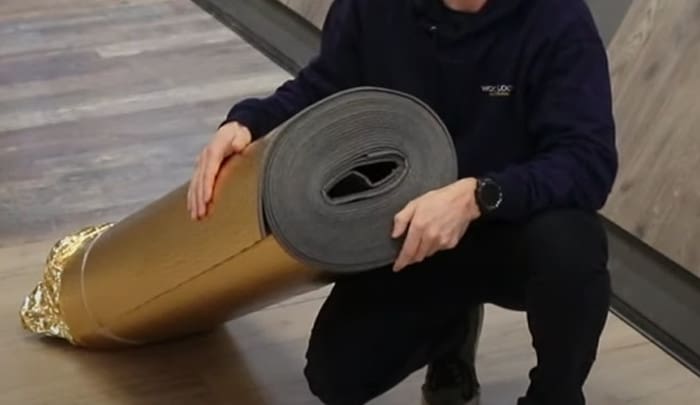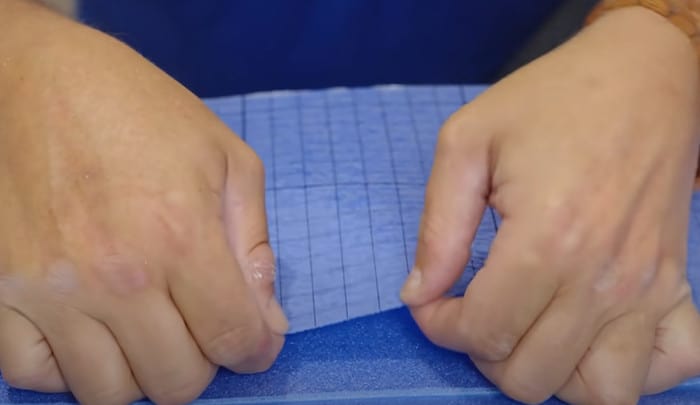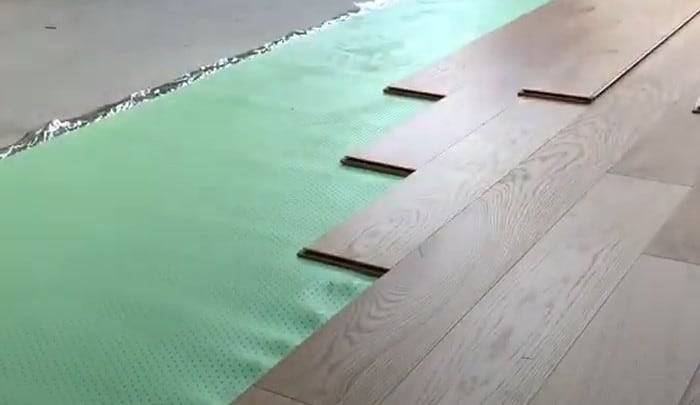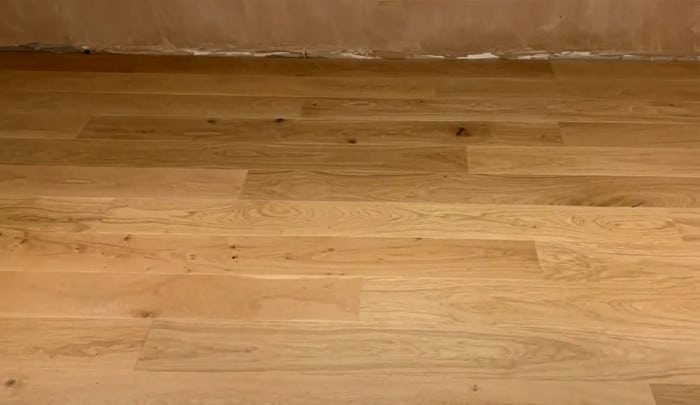As you prepare to install new hardwood floors, you may have so many questions swirling around in your head: What type of hardwood should I get? What color? What’re the wood planks cut like? Well, here’s one more question to add to the mix: Do I need underlayment for hardwood floor?
Underlayment for hardwood floors is not always necessary, but there are several key benefits to adding it below your new hardwood such as minimizing noise, providing extra cushioning, and protecting against moisture that might infiltrate through your floor and ruin it. The good news is that you have a lot of options when it comes to selecting underlayment – foam and cork foam, felt, and rubber are all materials that can be used in various combinations and thicknesses to meet any number of needs.
In this blog post, we’ll dive into the details of underlayment for hardwood floors to help you make an informed decision about what type of underlayment material is best for your home. We’ll discuss the benefits of underlayment, how it’s installed, and how to choose the right type for your hardwood floor. So, if you’re ready to learn more, read on!
It is recommended to use an appropriate underlayment when installing hardwood flooring. This will help reduce noise, control moisture levels, and provide additional insulation on your floor.
“Over the years, I’ve seen how the smallest details can significantly impact the long-term performance of your floors. The use of underlayment, though seemingly minor, is a crucial aspect of hardwood floor installation. It offers a range of benefits, such as noise reduction, additional warmth, and protection against moisture damage. In my experience, a good underlay can potentially extend the lifespan of your hardwood floor. Do yourself, and your floors, a favor, and don’t skip this step.”
Kaleb Vansickle, Certified Flooring Consultant
What is Hardwood Underlayment?
Hardwood underlayment is a thin layer of foam, cork, or another material that is installed between the subfloor and the hardwood flooring. Its purpose is to create an even surface that provides additional cushion and support for the hardwood floors. Hardwood underlayment also helps to absorb noise and provide thermal insulation, which can make your room more comfortable.
There are two sides to the debate surrounding the use of hardwood underlayment when installing wood flooring. On one side, proponents argue that hardwood underlayment provides several benefits such as improved acoustic performance, reduced expansion and contraction of wood planks, and improved moisture protection. On the other hand, opponents argue that there is no significant difference in sound or comfort with or without hardwood underlayment and that it can be a waste of money if you don’t need it.
Ultimately, both sides agree that if you are looking for optimal comfort and quieter noise levels, then installing underlayment is a good idea. However, if you are not concerned with either of those, then hardwood underlayment can be skipped without issue.
Having a better understanding of what hardwood underlayment is and its potential benefits gives us an insight into why this may be a necessary part of installation process when considering adding hardwood flooring to a home. But what exactly are the benefits of using hardwood underlayment? This is what we will explore next.
- Installing a high quality underlayment when laying down hardwood flooring can help significantly reduce the noise from walking on the floor.
- A study published in 2020 found that using an underlayment with hardwood flooring improved moisture resistance and could potentially extend the life of the flooring by up to 10%.
- According to a study published in 2019, paper or foam based underlayments can help absorb some of the impact force and increase the cushioning between the subfloor and the hardwood planks.

Benefits of Hardwood Underlayment
Underlayment is a great way to get extra cushioning and protection from your hardwood floors. It can provide an additional level of comfort as well as reduce sound transmission and absorb minor moisture-related issues that may occur. In essence, underlayment acts like a secondary barrier between the subfloor and the hardwood flooring.
The primary benefit of using underlayment is that it provides extra comfort, much like wearing a soft pair of shoes versus walking on bare feet. Further, it adds some warmth so in colder climates, using it could be advantageous. Additionally, when walking on hardwood floors, fewer sounds will travel thanks to the underlayment. Furthermore, if there is slight warping due to moisture changes, the right kind of underlayment will help in preventing issues before they become damaging to your finished flooring materials.
It’s important to note that although there are benefits to using underlayment for greater comfort and protection, it isn’t required for all types of hardwood floors. Laminate floors often require an underlayment, but some engineered and solid wood planks do not require any underlayment at all due to often being installed with adhesive or glue-down methods. Ultimately, it’s best to consult with installation experts who are familiar with your specific product for more guidance about whether you should use underlayment or not.
Given the many potential benefits of using hardwood underlayment, it’s understandable why so many homeowners choose to invest in it for their flooring project. Now let’s look at how getting extra cushioning and protection specifically can really make an impact on the beauty and longevity of your hardwood floor installation.
Next we’ll look at what extra cushioning and protection means for your hardwood floors, as well as practical ways to ensure you maximize its benefits.
Extra Cushioning and Protection
Installing underlayment beneath hardwood floors offers extra cushioning and protection, which can determine how well it performs in the long run and how comfortable it feels. Generally, thicker types of padding are best for more cushioning needed, while thinner types are better for situations in which a tighter bond between the subfloor and the finished floor is desired.
Adding an extra layer of cushioning has several benefits. It absorbs vibrations, providing a much more pleasant walking experience. Furthermore, it also provides additional insulation—which can help keep heat in during winter months and reduce energy bills. Conversely, some people advocate for doing without underlayment all together. They suggest that without it, there is less thermal mass to absorb heat, which keeps interior temperatures cooler in the summer months.
In the end, it really comes down to a matter of preference and budget. Those who value comfort may choose to go with added cushioning and insulation, while those looking to save on costs may decide against it.
No matter what decision you make, ensure that your floor installation meets all relevant building code requirements for moisture and fire safety where you live.
The next section will consider noise and sound reduction potential when using underlayment beneath hardwood floors.
Crucial Points
Adding an extra layer of cushioning in the form of an underlayment beneath hardwood floors provides several benefits, including vibration absorption and insulation to keep heat in in the winter and reduce energy bills. Ultimately, whether you choose to go with extra cushioning or not is up to you and your budget, as long as your floor installation meets all relevant building code requirements. The next section will consider the noise and sound reduction potential when using underlayment beneath hard wood floors.

Noise and Sound Reduction
Different types and thicknesses of underlayment can offer many benefits for hardwood floors. One of these benefits is improved sound reduction, both from walking on the floor as well as airborne noise from surrounding spaces. Many people also choose to install underlayment if they want to reduce noise which travels through their floorboards to downstairs neighbors or other dwellings in the same building complex.
The debate about whether underlayment provides significant sound reduction tends to divide opinion. Some people argue that thicker underlays can make a huge difference, while others suggest that any benefit is negligible. It seems agreed upon, however, that a good quality underlayment can provide additional soundproofing compared with using a bare hardwood floor. This means it may be worth considering an appropriate underlayment if you’re looking to reduce noise levels in your home or workplace.
What’s more, some types of high-end foam and cork underlays even include special adhesives which bond them securely to surfaces below, providing an extra layer of protection against impact sounds. Talking to professional installers should help ensure you find the right type of underlayment for your needs—both in terms of fit and sound reduction.
Having established the potential noise reduction benefits of underlayment for hardwood floors, the next section will discuss the different types available.
Types of Underlayment For Hardwood
When selecting the type of underlayment for hardwood flooring, the most important factor to consider is the thickness and sound insulation properties of the material. Different types of underlayment offer different levels of protection, sound deadening, and cushioning for your floors.
For nailed or stapled hardwood floors, it is most common to use a thin layer of felt paper with asphalt adhesive as an underlayment. This acts as a moisture barrier, cushioning the planks from each other and helping to reduce noise. Additionally, felt paper can be installed easily since it is available in large rolls and comes with an adhesive backing that makes installation quick and easy.
Alternatively, foam underlays are also becoming increasingly popular among those installing hardwood floors. Foam underlays offer superior impact and sound reduction due their thicker construction compared to felt paper underlayment. Additionally, foam underlays provide additional warmth which can reduce energy bills and help keep a home warmer in winter months. On the downside, foam underlays cost more compared to felt paper underlays, have higher installation requirements due to their thicker construction, and may not be as effective at moisture-proofing as felt paper due to their closed-cell structure.
Overall, selecting an appropriate type of underlayment for hardwood flooring depends largely on your needs. If you are looking for superior sound proofing options or want the added warmth provided by foam underlays, then you will want to look deeper into these options before making a decision. The next section will focus on the topic of foam underlayment so read on if this is something you may be interested in exploring further.
Foam Underlayment
Foam underlayment is a popular and relatively affordable option when it comes to providing a cushioning for hardwood floors. It provides sound insulation, and many come with anti-microbial treatment that retards the growth of mildew. However, there are some drawbacks to foam underlayment, in particular that the cushioning might not be thick enough for some high traffic areas and can wear out quickly with constant use.
For households with young children or heavier traffic, a foam underlayment may not be the best choice as they can become thin or broken down over time. Additionally, this type of underlayment doesn’t provide much thermal insulation, meaning it won’t do much to retain heat in your home, especially during colder climates. The biggest advantage of foam underlayment is that it’s inexpensive and makes laying floorboards easier and faster.
Of course, this isn’t true for all foam underlayment products. Some higher quality foams are thicker and sturdier, offering better protection from impact and sound insulation than their cheaper counterparts. They also may contain a moisture barrier built into them, making them better suited for damp environments. Still, even the most expensive forms of foam are unlikely to offer protection against significant movement in the subfloor or humid temperatures over long periods of time.
With this in mind, it is important to weigh both the benefits and risks when choosing foam underlayment for hardwood floors. It is usually a good choice if you are on a budget or need extra cushioning in low-traffic areas like bedrooms or living rooms.
Now that you know more about foam underlayment, let’s talk about the next step: moisture barriers. Moisture barriers provide an extra layer of protection between the flooring and any water that might absorb down through the substrate into the subfloor below.
Moisture Barrier
If you are considering installing hardwood flooring, one of the most important considerations is whether or not to use a moisture barrier. A moisture barrier is a special material usually made of plastic, that sits between the subfloor and the hardwood planks. It’s designed to protect against water seeping into the floor from below and potentially damaging or warping the wood.
While there is some debate as to whether a moisture barrier is necessary for hardwood floors, many experts agree that adding an extra layer of protection can help prevent water damage in the future. This is especially true if you live in an area with high humidity or frequent rainstorms. The extra layer of water blocking material could save you money in costly repairs down the road.
On the other hand, some homeowners argue that the use of a moisture barrier is unnecessary, citing cost and extra time needed for installation as two main factors. While it may be true that moisture barriers can increase costs and installation time, experts still suggest using them as extra protection against water damage. Even if you don’t experience flooding issues with your home, higher humidity levels caused by climate change could pose problems if your wood isn’t properly sealed with a moisture barrier.
Therefore, while each individual must decide whether they think it’s worth the expense to install a moisture barrier underneath their new hardwood floors, experts generally agree that it’s an essential step in protecting against potential water damage from below.
Next, let’s take a look at the next step in hardwood flooring installation: Do I Really Need Hardwood Underlayment?

Do I Really Need Hardwood Underlayment?
This is a question many homeowners face when considering hardwood flooring. On one hand, there are certainly benefits to be gained from laying down an underlayment prior to installing the hardwood floor. On the other hand, adding an extra layer of material may not be necessary in some cases.
For starters, underlayment works as a moisture barrier and provides protection against moisture content fluctuations in subfloors. In addition, it helps with sound absorption, insulation and provides cushioning that helps the flooring last longer. These features can help preserve the quality and condition of your hardwood floors over time.
On the other hand, there are certain types of flooring that don’t necessarily require an underlayment underneath them. For instance, engineered wood or laminate wood may not need it depending on where you live and the type of subfloor present in your home. In these cases, you likely won’t see any long-term benefits from using an underlayment, which could make it a waste of money and resources.
Only you can decide if you need an underlayment for hardwood flooring based on your specific needs and situation. You may want to consult with a professional who has experience working with hardwood floors in order to get informed advice about whether or not using an underlayment makes sense for your project.
It is clear that selecting or omitting an underlayment for your hardwood floor depends heavily on your particular situation and needs. However,cost savings can easily be realized regardless of whether you ultimately choose to buy one or not. The next section will discuss in further detail the cost savings of buying or not buying underlayment.
Cost Savings of Buying or Not Buying Underlayment
When considering whether to buy underlayment or not, one of the first thoughts that comes to mind is cost. Underlayment offers several key benefits for hardwood floors including moisture protection, sound reduction and added comfort, but does it make sense financially?
The cost of buying underlayment upfront can run between 50 cents and $1 per square foot. Anywhere from 30 to 100 extra square feet should be planned for in addition to the total amount of hardwood being purchased. This will account for any surprises during installation and any scrap left over from trimming boards.
A common debate is whether it is easy enough to install the underlayment yourself as a DIY project as opposed to paying someone else to install it, as an additional cost. Although, this may depend on a person’s budget, skill level and time constraints, it certainly could be a route someone might take. On the other hand, if money is not an issue then hiring a contractor who has done this type of work before may be the way to go if installing flooring correctly is high priority. With this method there is also some piece of mind knowing that the job was done right and it is backed with some warranty and longevity assurance.
Another factor to consider when making the decision regarding underlayment is that although it costs more upfront in terms of purchasing material, it can potentially save money in other ways such as improved energy efficiency with noise control capabilities from using certain types of underlayment products.
Ultimately deciding whether or not to purchase and install underlayment for hardwood floors largely depends on an individual’s personal preference, budget and desired outcome for their flooring. While there are some cost savings associated with purchasing or not purchasing underlayment, taking all other factors into consideration provide a clearer picture of what option makes the most financial sense.
Final thoughts on hardwood underlayment are important when making a decision about the type, if any should be used during installation. Factors such as budget, preferences and desired outcome can all influence how one reaches their conclusion about using or skipping over using an underlayment altogether. The next section will provide some more insight into what needs to be taken into consideration when making this important choice for your hardwood floor project.
Final Thoughts on Hardwood Underlayment
When it comes to choosing an underlayment for hardwood floors, the decision ultimately comes down to determining what type of floor best suits your needs and budget. Each type of underlayment has its own unique benefits and drawbacks, and no single material will be right for everyone.
For instance, foam underlayment is a cost-effective option that can easily be installed over concrete or plywood subfloors, but it lacks some durability. Cork underlayment is sound absorbing and eco-friendly, however, it may be more expensive than other options. Rubber underlayment has excellent soundproofing capabilities, but can be susceptible to moisture damage if not properly sealed.
Ultimately, no matter what type of underlayment you choose, it’s essential to take into account any potential special requirements for your specific installation in order to ensure the most successful outcome. Depending on the particular flooring surface and condition of the subfloor surface below it, additional supplementation may be necessary. For example, if your subfloor has large voids or cracks then self-leveling compound may need to be applied prior to laying the underlayment. Similarly, if there is moisture detected then moisture barrier should also be considered when selecting an appropriate underlayment material.
Final thoughts on hardwood underlayment generally come down to two basic considerations: choosing an appropriate floor covering and securing proper installation of the material in question. Take the time to research local building codes for building materials allowances in your area as well as finding out what types of warranty are provided by local retailers for products purchased. This will help you select a quality product for optimal protection that ensures a successful final result with minimal problems down the road.

Common Questions
What types of underlayment are appropriate for hardwood floors?
There are several types of underlayment that are appropriate for hardwood floors, including foam, felt, rubber, or cork underlayment. Foam underlayment is typically the most affordable option and is designed to absorb sound and provide extra cushioning. Felt underlayment, on the other hand, offers superior soundproofing and shock absorption capabilities. Rubber and cork provide greater levels of moisture protection than other materials but are more expensive. Overall each type of underlayment has its own advantages and disadvantages. It’s recommended to research all options and compare qualities before making a decision.
What are the benefits of using underlayment for hardwood floor installation?
Underlayment for hardwood floor installation offers many benefits. The primary benefit is that it helps reduce noise. Underlayment cushions the floor and provides additional sound absorption, meaning that you won’t be able to hear as much foot traffic in the room, nor will sound travel through walls when loud activities are happening. Additionally, underlayment also helps to smooth out irregularities in the subfloor, making for a smoother, more even finish after the hardwood is installed. This can help prevent any potential squeaking in the future. Finally, it provides a vapor barrier which helps protect against moisture damage, helping your floors last longer over time.
Are there any disadvantages to using underlayment for hardwood floor installation?
Yes, there are a few potential disadvantages to using underlayment for hardwood floor installation. Firstly, the use of underlayment adds an extra cost to the installation since you must purchase the additional material and spend time installing it. Additionally, depending on the type of underlayment used, there may be an additional risk that dampness can seep through and cause damage to the hardwood floor over time. Also, underlayment may slightly reduce the overall level of sound insulation provided by your hardwood floor installation. Finally, it is important to ensure that you choose the right type of underlayment in order to maintain a smooth and even surface across your entire hardwood floor.
References
https://www.homeflooringpros.com/underlayment/
https://www.hgtv.com/design/decorating/design-101/how-to-install-underlayment-and-laminate-flooring





While working as a professional carpenter, I always insisted on using underlayment for hardwood floors, primarily because of its protective features against moisture. Over the years, I’ve seen floors without it suffer moisture damage, which makes the initial cost of underlayment well worth the protection it provides.
As a homeowner considering installing hardwood flooring myself, could adding underlayment potentially increase the house’s overall value or is its main purpose more about protection and comfort?
Tarquin, investing in underlayment definitely provides protection and comfort, but in my view, it also enhances your space’s acoustic properties which might indirectly add to your home’s overall appeal thereby potentiating its future market value.
Not just the acoustic factors Vasco, underlayment also significantly affects temperature regulation by providing added insulation which in turn may help curtail energy expenses. Moreover, it helps to extend the life of your hardwood floors by offering an additional protective layer against regular wear and tear.
The underlayment has indeed been an important aspect of my own projects; it provides a touch of luxury with its added cushioning which most homeowners appreciate.
From my experience, using an underlayment for hardwood floors is integral not just for comfort but also improves the longevity of the wood floor by providing an extra line of defense against moisture.
Absolutely agree with you, Flanagan. Underlayment has saved many a floor from unsuspected moisture damage in my experience. And not to mention the noise reduction bonus – it helps keep peace when your grandkids are running around like little goblins on your newly polished wooden floors!